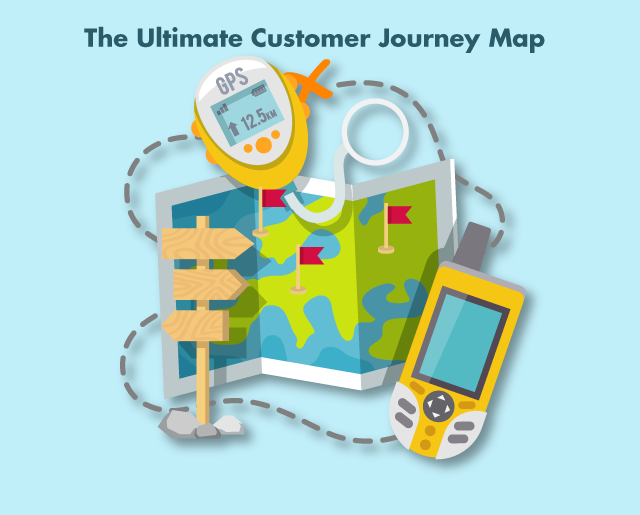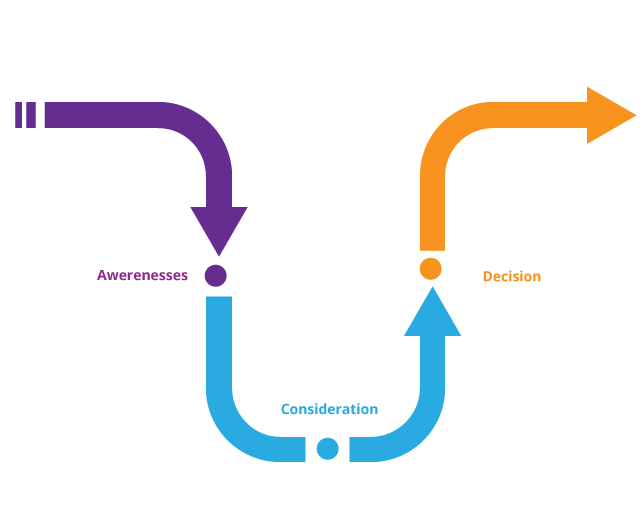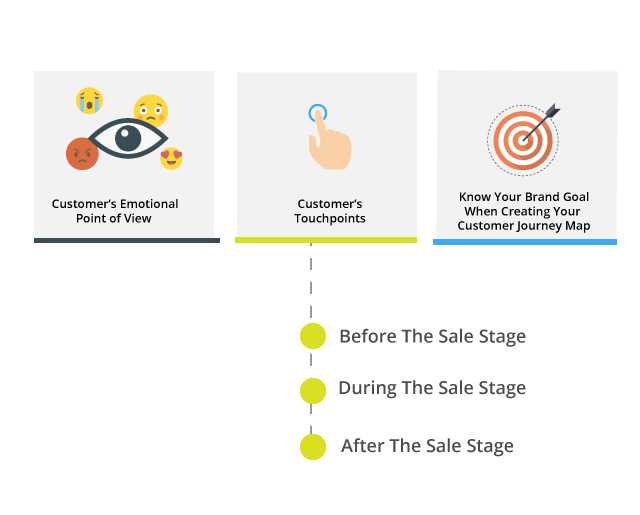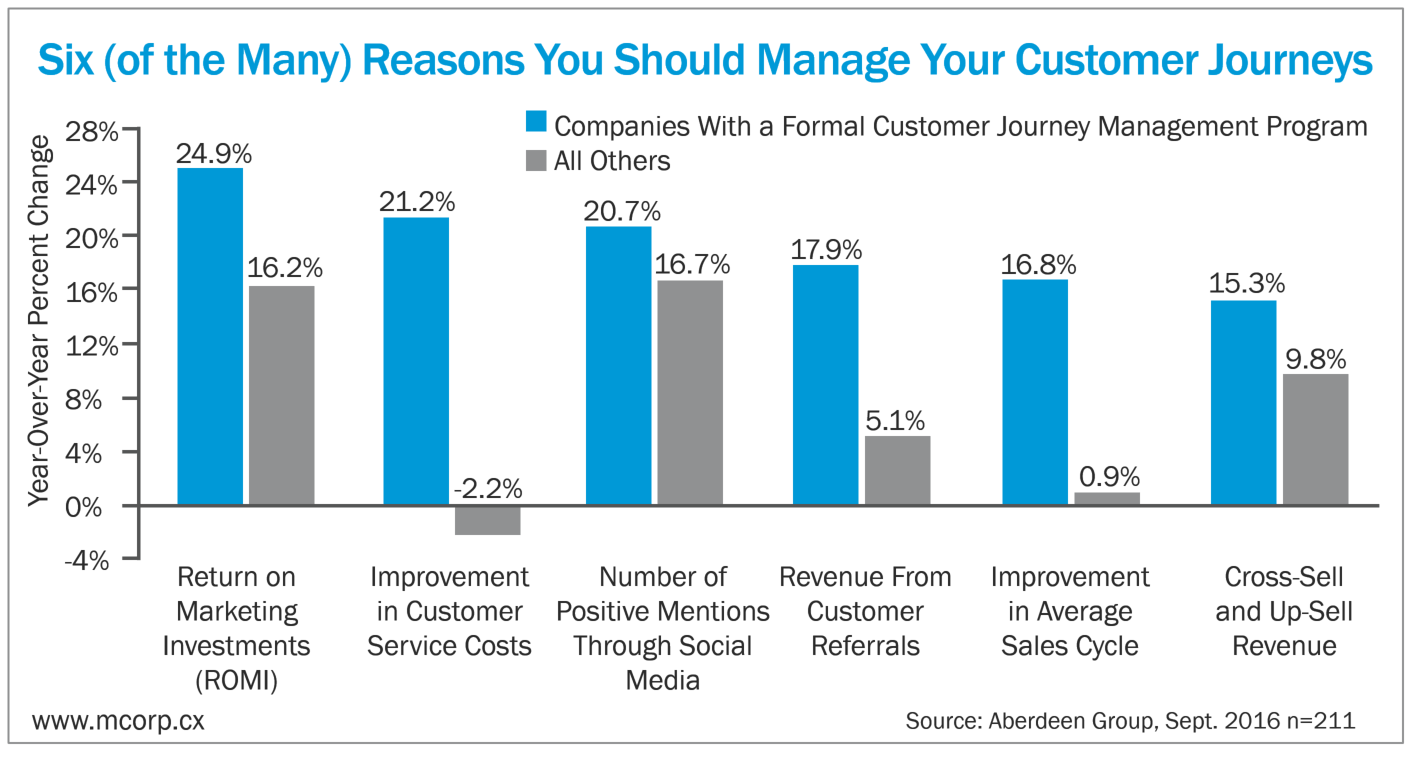
This blog post was originally published on WebMaxFormance.
If you’ve been searching Google for information on “How To Create a Customer Journey Map,” you are probably tired by now… because you still don’t have a clear answer.
Yes, a lot of articles talk about Customer Journey Maps, but how many of these articles have given you the specific enough information that you need? Even fewer give this information in the form of a guide, with steps to follow and build a solid Customer Journey Map.
But, don’t worry. In this article, we prepared everything you need to know about the Customer Journey Map and how to create one for your business.
For the sake of convenience, we will use the term ‘Customer’ throughout the article even though a person is not a Customer until they make a purchase.
So, let’s get started.
What Is A Customer Journey Map?
First of all, let me explain what a Customer Journey Map is and why it’s important for your business.
We, marketers, love to tell stories. But, if we want to tell a story that keeps our audience at the edge of their seats, munching popcorn as their minds are completely locked into the storyline, first we need to learn how to listen.
- Listen to the stories your users are telling.
- Listen to the frustrations they face every day.
- Listen to the aspirations they have.
- Listen to the expectations that arise after finding a product/service that would hopefully solve a particular problem.
Why is this “listening” important for your Customer Journey Map? Because, in the marketing world, users are speaking through the Customer Journey Map.
“A Customer Journey Map is the visual representation of the series of actions your customers or prospects are making to achieve a goal with your company.” It gives you a perspective of your customers’ thoughts, fears, pain points, or strong sides.
Rather than just being a casual journey that goes from point A to point B, the Customer Journey Map has a lot of bumps along the way. And this is normal since people are complicated beings. Often, when we think we want one thing, halfway “there” we change our minds, or we find something new that is more interesting. And sometimes… many times actually, a competitor pitches in and steals our prospect’s focus.
The goal of an effective Customer Journey Map is to predict all of these “bumps along the way” and include solutions, so prospects would continue down YOUR map.
To do that, you need to understand the Customer. And understanding your customer starts with creating a User Persona.
User Persona: Ground Zero For Effective Customer Journey Map
A User Persona is the psychological profile of your ideal customer. It includes demographic characteristics, personal preferences, deep convictions, opinions, desires, fears, and so on.

Image Source: The 2016 Benchmark Study
To create a detailed and accurate User Persona, marketers spend a lot of time doing market research, checking analytics, doing surveys, spying on the competition and so on.
But, even with the availability of this data, businesses still struggle at capitalizing their User Personas.
Think about this: Marketing is a multi-billion dollar industry. Yet, all that money, can’t help marketers to speak to their prospects effectively.
A scary majority of businesses do a lot of guesswork with their money… HOPING that “something” would happen from all that activity. But, if it is not planned, it can just happen out of the blue.
You need to know your User Persona to communicate with your Customers effectively.
Check what businesses are saying when asked why their User Persona may not bring the best results.
Maybe it’s not the data that’s the problem, but what we do with it. The leap from Data to Insights is the key issue. Marketers get stuck on data gathering, and then they struggle in figuring out what to do with it.
The way out of this mess is to divide data gathering to Analytical and Anecdotal part of the research.
Let me explain.
Analytical Research
Every measurement your business does go into this file – the Analytics.
Google Analytics, for example, is a great source of gaining information about how your users interact with your website.
However, there is a curve line here. Not every statistic should be taken for granted. Increased bounce rates, for example, may occur not because you don’t have a CTA button, but because the content is too difficult to read.
Or, clicks. Clicks are not always a sign for great UX. Sometimes users may be too confused to figure the page out.
Doing surveys is another analytical way for a business to get in touch with their users and gain insight into their perspective.
If used the right way, Analytical Research is one of the best and easiest ways to collect information.
Anecdotal Research
Anecdotal Research is more challenging and requires more skills because it requires a more personal approach to the user. What does this mean? It means:
- Constant collaboration with sales and Customer support departments
- Using social media for gaining information
- Reading forums on the same subject
- Doing personal interviews
It might be more difficult to get in touch with the user on a personal level, but Anecdotal Research gives you insights on much more valuable thoughts, opinions, and problems that your user is facing.
With these insights, you’ll be able to design a better User Persona that will get you one step closer to your ideal user. All this leads to the question relevant to you as a brand:
Why Is It Important To Create A User Persona?
Creating a User Persona can be beneficial for your business for various reasons:
- Gaining a clear perspective of your Customers and their understanding of your marketing message,
- Focusing your company’s culture on your Customers, not your brand,
- Creating a more personalized approach which allows you to meet them where they needs are.
Most importantly, creating a User Persona is useful for understanding the Customer journey stages.
Take a look at what I am talking about.
The Top 4 Customer Journey Map Stages

Why are Customer Journey Map stages important for your brand?
Your users are going through a multiple-step process before turning into your Customers.
If your marketing team is not aware of all of them, how could they possibly act upon them? And how will they develop a suitable marketing strategy that will level with your Customer’s emotional stage?
That’s why you need to know each emotional stage your Customer is going through.
Let’s start from the beginning.
Customer Journey Map Stage #1 – Awareness
The ‘Awareness Stage’ is the first stage in the Customer Journey. At this stage, the Customer may not be aware of your brand’s product or service, or the fact that they have a need for it.
The Customer might have seen your advertisement or has come across a blog post that explains a certain industry-related question. But, the real question is: How to get your Customer beyond this ‘unrecognizable phase’ in the Customer’s head?
This is what marketing teams are responsible for. It’s their job to develop a marketing plan that will present your product or service to your Customers.
What’s crucial to remember at this stage is that the center of your brand is the Customer, not your brand.
At this stage, your company needs to provide value or solve certain problems or doubts that your Customers are having. It’s the only way to build trust between Customers and your company.
Educate them on the subject instead of looking for an immediate validation or credit card number.
Customer Journey Map Stage #2 – Consideration
The second stage is actually the accepting stage. Here, every Customer accepts that they are having a problem and are willing to find a solution for it.
But, this one is one extremely tricky stage. If businesses don’t show a certain understanding of the Customer’s problems and needs at this point, they might face the consequences of losing the Customer’s trust. Which means losing the possibility of making that prospect a valuable Customer.
If you immediately try to engage Customers and offer them a product, they will see right through you. Be patient at this stage. It might take time for users to get closer to your brand, but they will. And once they do, you’ll have their trust long-term.
Customer Journey Map Stage #3 – Decision
The third stage is all about taking action. Here, your Customers may still feel kind of skeptical about your product, but, hey, your product is on their research list.
They turn to Google to look for comparison blogs, they are reading reviews and watching videos. Customers at this stage want to know more about how the product is used, in what way you provide the services and what your current clients have to say about your product.
They compare prices and benefits.
This means that it’s your time to shine. It’s the right moment to show the features of the product, the team that stands behind, the benefits each Customer will experience, and how your solution will help them.
All in all, smart moves at this stage could be the key difference between a successful marketing strategy and an ALMOST successful strategy.
Customer Journey Map Stage #4 – Nurture
Most businesses have this idea that once their Customer checks out their webpage, their job is done. Wrong!
The real power of any company lies in what the marketing team does AFTER the Customer buys your product or service. Your marketing team should use a content marketing strategy designed only for this group of Customers.
When you show appreciation to your Customers, they will show their appreciation for your brand. The right marketing strategy can increase the Customer’s trust in your brand and your brand’s credibility because satisfied Customers are not shy with words and reviews. The word of mouth they can provide is the most valuable asset against your competitors.
Now that you are aware of the Customer Journey Map stages, it’ time to get practical.
That’s our next stop – explaining what a well-designed Customer Journey Map includes.
Take a look.
The 3 Important Elements Of A Successful Customer Journey Map
Remember at the beginning, when we explained Customer Journey Map as users’ way to talk to brands?
So far, we’ve talked about the User Persona and how it benefits your brand. We’ve clearly defined the stages in one Customer Journey Map. Now, it’s time to dive a bit deeper and explain the elements every successful Customer Journey Map needs to include.

And don’t forget, keep your hands on the steering wheel and your eyes on the Customer because this journey is all about them.
Let’s begin.
1. Customer’s Emotional Point of View
You would be surprised to see how much your Customer’s emotional point of view can change their attitude towards your marketing.
You need to remember that your Customers are humans. They experience powerful emotions evoked by their opinions and thoughts about your product or brand.
Mapping Customers’ emotional point of view can make you understand them better and see what you can do to help them.
Knowing and acting upon their thoughts and goals is one highly effective way of businesses communicating with your Customers.
2. Customer’s Touchpoints
Every user interaction with your brand is known as Customer’s touchpoint. These touchpoints can be positive or negative. To identify them, you need to know all of your brand’s communication methods, both form the offline and online world:
- PR Department of your company
- Social Media Ads
- Offline Marketing
- Word of Mouth
- Reviews
- Forums
Some of these means of communications can be controlled by your brand, but others not so much. That’s why it’s important to be aware of them and act upon them. That’s the only way those touchpoints will be positive and provide a better Customer experience.
To better understand and define the touchpoints, think about the user in 3 phases:
Before The Sale Stage
When a Customer first discovers your brand it counts as ‘before the sale stage.’
If you are Coca-Cola, chances are, your Customers don’t experience the before stage because this brand is known worldwide. But, many brands are unknown to Customers. And that process of how Customers become aware of your brand is the first stage.
During The Sale Stage
‘During the sale stage’ is the stage when Customers are already aware of your business.
At this stage, they research your product and brand.
But, this is also the time when you gather information about your Customers through the means your company uses for communication.
After The Sale Stage
Closing the deal doesn’t mean you need to stop communicating with your Customer. In fact, taking care of your Customer’s needs after they offer you their trust is crucial for developing a valuable B2C relationship.
Show your customers that you really care about them. To do that, your team can use:
- Online help centers
- Thank you e-mails
- Follow up e-mails
- Marketing e-mails
Remember, these are only basic touchpoints. Knowing all the different touchpoints your company uses to keep in touch with Customers will help your business to provide better Customer experience.
All these pieces of information can pave the road to creating more effective brand goals.
And that is the last element of the Customer Journey Map.
3. Set Your Goals When Crafting Your Customer Journey Map
Your company is probably going to need to design several Customer Journey Maps. Not every map will be in line with each user’s needs and desires.
With creating the maps that will anticipate the road your Customer is taking to achieve a goal, you can define better goals for your company.
The map should start with your Customers in mind and end by defining your company’s goals.
The Benefits Of Creating A Customer Journey Map

As you can see from the image above, having a Customer Journey Map turned out to be highly valuable and profitable. No matter the industry you are working at, chances are, you have competition. And probably, a fierce one too.
Creating a Customer Journey Map will increase the chances to be one step ahead of your competition. But this is just one of the many benefits that follow below:
- Understanding your users better. When creating a Customer Journey Map, you get to know your users. You learn about their positive and negative experiences, their goals, and their pain points. Understanding your users better means that you can get closers to them, which will enable you to help them in a more efficient and specific way.
- Understanding your company communications better. This doesn’t refer only to external communication, but also to internal communication. This way you’ll discover all the means of communication your marketing team needs to properly analyze and prioritize and as such, provide increased efficiency in their work.
- Discover new business opportunities. You might be doing an excellent job when it comes to connecting with your Customers, but there’s always room for improvement. Creating a Customer Journey Map can show all the untouched areas of your customer journey. Your team will be able to recognize and define areas that were lacking any type of marketing strategy. With the Map, your team can develop a strategy that will be just right for the Customers that seem to be forgotten by your brand.
- Increasing sales and reducing costs. It’s no secret: if you provide better user experience, the sales will increase. It’s a simple formula – if you care about your Customers they will show their appreciation. And creating a Customer Journey Map can be the tool to develop a more personalized approach towards your user. You will make the journey for your Customer easier and more approachable which will reduce costs and increase sales.
Let’s Wrap Up
As it turns out, every journey has an endpoint. And ours is here. We had several stops down the road, and all of them revolved around creating a better Customer Journey Map.
With the starting point being a clarification of what Customer Journey Map is, we have expanded our journey to a more detailed representation and explanation of the entire process.
The gist of the Map is the User Persona. It has all the relevant characteristics of your ideal Customer. And it’s absolutely necessary to develop a functional Customer Journey Map.
Bear in mind though, to create that kind of Persona you’ll need good and detailed research.
After finalizing the process of creating a User Persona, the next step is to understand the different stages every journey has.
Awareness, Consideration, Decision, Nurture – get familiar with those terms because they can make all the difference between you and your competition. Dedicate some time to these stages for better understanding. Don’t rush through them.
The most important thing though is to listen to your Customers all the time.
Especially pay attention to their way of speaking through touchpoints. Acknowledge your touchpoints, so you can see more clearly where your users are stuck somewhere in their customer journey map.
In the end, we defined the benefits of having a Customer Journey Map for each business. They are crucial for a successful and growing business.


Recent Comments